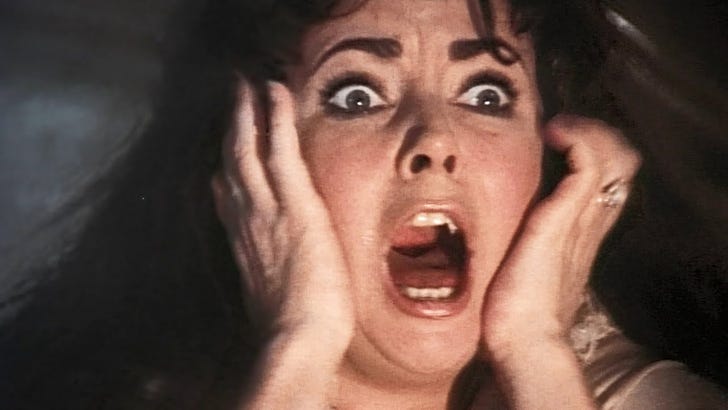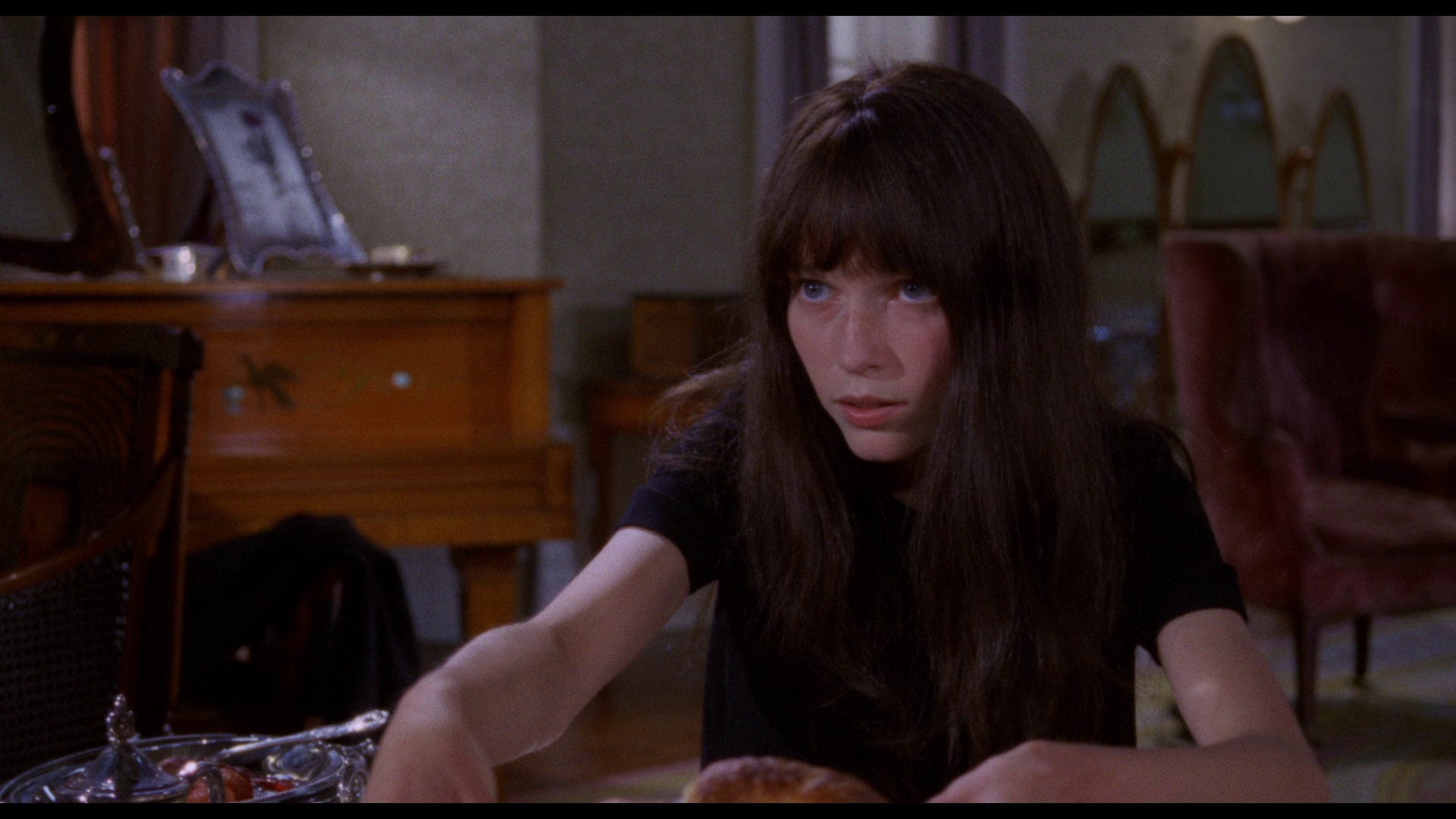Electric Theatre: Secret Ceremony (1968)
Scott Barnett follows Elizabeth Taylor into the Gothic corners of Holland Park
Electric Theatre is our rotating column, where we look at London on film. It’s an opportunity to see how the city has been represented on the big screen over the years, how its landmarks and structures have been used (and abused) and how various genres and directors extract wildly different performances from its streets.
For this latest instalment, Scott Barnett wades into the psychosexual mind games being played out between Mia Farrow, Robert Mitchum and a fully-charged Liz Taylor amongst the lush interiors of one of London’s most extraordinary houses.
Welcome to the Electric Theatre. Please turn off your phones and refrain from talking for the duration of the entertainment.
If you turn right when exiting Holland Park tube station, walk past Daunt Books, Nicolas wine merchant and the historic C. Lidgate butchers shop (founded 1850); go past the Ukrainian embassy on the other side of Holland Park Avenue; then turn left and continue down Holland Park Gardens, you will eventually arrive at one of the most jarringly ostentatious residences in the capital.
Debenham House was designed in 1905 by Halsey Ricardo for department store owner Ernest Debenham and granted Grade I listing in 1969. With its Italianate facade and Arts and Crafts interior, 8 Addison Road is an explosion of colour in an otherwise tastefully affluent neighbourhood (its other moniker, Peacock House, is entirely fitting). Although, the dearth of information available online about this fascinating mansion suggests that Debenham House has yet to strike a chord with contemporary architecture enthusiasts, and not everyone is a fan. Jonathan Meades once described it as “structurally stodgy — an alderman dressed as a hippy”.
Indeed, most people who know of Debenham House were probably exposed to it in the same way I was: through Joseph Losey’s misunderstood 1968 cult classic, Secret Ceremony; a film that continues confound and delight viewers over half a century after its theatrical release.

More haunting than Rosemary’s Baby!
In a dank and dingy London flat, sex worker Leonora (Elizabeth Taylor) looks into a mirror and removes a blonde wig as one of her clients exits. A little while later she leaves the flat and flags down a number 27 Routemaster bus. While sat on the top deck she is approached by Cenci (Mia Farrow) who is seemingly transfixed by her. When Leonora stands up to get off the bus, Cenci whimpers “Mummy” and follows her. Maybe in an attempt to evade Cenci’s advances, Leonora makes her way towards St. Mary Magdalene church in Paddington (Modernist architecture fans will no doubt be excited to see Princethorpe house looking brand new in the background), to place flowers on the grave of her daughter, who drowned at just thirteen years old.
Leonora turns and stares at Cenci, and the two maintain eye contact until Leonora begins to feel faint and almost passes out. Cenci escorts the older woman back to Debenham House, where Leonara discovers a photo of Cenci’s mother, to whom she bears a striking resemblance. This is just the beginning of the bizarre role-playing games that will fill the rest of the film.
Secret Ceremony is an early example of the wonderfully-named Lizploitation sub-genre; a run of films Taylor made in the late sixties and early seventies following the Cleopatra fiasco, when her box office bankability was on the wane. These were odd little films, often critical and commercial failures in which Taylor nevertheless gave fully-committed (sometimes too committed) performances, usually in some of the most remarkable outfits ever committed to celluloid.
Prime examples of Lizploitaion would include Reflections in a Golden Eye, Boom! (more on which later), Zee & Co, and the gloriously bizarre adaptation of Muriel Spark’s deeply unsettling novella The Driver’s Seat.
I have a fondness for all these films, but Secret Ceremony is of a much higher calibre than the rest. Taylor’s performance is so watchable that you don’t mind that her accent can’t decide which side of the Atlantic it belongs, veering from RP English to sassy Bronx (“she didn’t give me a red cent”); and it goes without saying that she looks amazing as she helps herself to the contents of Cenci’s deceased mother’s lavish wardrobe. There is also a real complexity to Taylor’s performance, as her motivations - initially purely financial - become less clear and she disappears deeper into the role of Cenci’s mother.
Twenty-two-year-old Mia Farrow, on the cusp of stardom and in a turbulent relationship with Frank Sinatra at the time, is pitch perfect. Wearing a long black wig to hide the iconic Vidal Sassoon pixie-cut she sported in Rosemary’s Baby, Farrow gives an utterly convincing performance as the troubled, infantilised heiress. It’s not an exaggeration to say that the whole film hinges on the viewer being able to identify with Cenci’s trauma, and Farrow’s performance is more than up to the task. The scene in the kitchen where she acts out the abuse she has suffered (unaware that she is being watched by Leonora), is jaw-dropping. I’ve always felt that Farrow has never really received the credit she deserves as an actor and Secret Ceremony is evidence of just how good she can be.
The real head-scratcher here is Robert Mitchum’s sleazy and oddly indifferent performance as Cenci’s stepfather, which has to rank as the most unflattering role of his long, illustrious career. In his trench coat and unconvincing stick-on beard, Mitchum is quite blatantly phoning it in. I’m certain his reason for accepting the part was financial, but this somehow serves to make his performance all the more chilling. We have seen terrifying Mitchum performances before of course (Max Cady in Cape Fear and the murderous Reverend Harry Powell in the Night of the Hunter), but there is something here that I find much more difficult to watch. Before he eventually bulldozes his way into the narrative, Mitchum’s character is seen lingering outside the house, insolently whistling and it is achingly clear that this man is bad news. By all accounts, relationships were also strained behind the camera, where Mitchum spent most of his time writing poetry and reciting his efforts to Farrow. The rumours are that Losey was seriously consdiering firing Mitchum and giving the role to Richard Burton instead.
Just great cinema
If you’ve been made aware of the existence of Secret Ceremony before, it is quite likely due to it appearing on a list of camp classics or films that are ‘so bad they are good’. It usually gets mentioned in the same breath as the extraordinary Boom!, which was made in the same year and also starred Elizabeth Taylor in a, shall we say, full-throttle performance. This possibly reveals more about me as a viewer than it does about the film, but, with the exception of some of Liz’s more hysterical moments, I don’t find Secret Ceremony camp, at all. It’s just great cinema.
Boom!, on the other hand, is everything people say it is and a whole lot more. It will come as no surprise that the high priest of trash, John Waters, called Boom! “the best failed art movie ever,” describing it as “beyond bad. It’s the other side of camp. It’s beautiful, atrocious, and it’s perfect”. But, where Boom! is clearly a production that has come completely off the rails (Burton and Taylor’s rumoured Bloody Mary breakfasts probably not helping matters one bit), there is not a single moment of Secret Ceremony that feels like Losey isn’t totally in control of his material.
If I was going to compare Secret Ceremony to another Losey picture, it would be The Servant (1963), the film that is commonly considered to be the director’s crowning glory. Both take place in lavish London homes, where the lives of the naive, childlike occupants (James Fox as Tony in The Servant and Farrow as Cenci in Secret Ceremony) are irrevocably altered by the entrance of outsiders. The use of mirrors in both films is also ingenious, but that’s probably an entire essay in itself.
When location scouting was taking place for Secret Ceremony, Wisconsin-born Losey - who had been working in the UK since being blacklisted during the McCarthy witch hunt - had no hesitation in suggesting Debenham House as the centre piece for his psychodrama. He passed the building every day while taking his son Joshua to school, and the cinematic potential of the property would have been obvious to the director who was renowned for his ability to create isolated, interior worlds.
At the time, the house had fallen into disrepair and was being used as a church-run refuge for mental health patients, so the financial boost from what was a big Hollywood production (although one being shot in the UK) would have been timely and very much welcome.
Within the bejewelled interiors of Debenham House, with its ostentatious tiles, stained glass and mosaics, Losey found the perfect place for his characters to cut themselves off from the real world. Throughout Secret Ceremony, Losey uses those interiors to masterful effect and even though the bedroom and bathroom scenes were shot separately at Elstree Studios, you really can’t tell unless someone points it out to you.
Regular Losey collaborator Richard Macdonald’s production design is flawless and Secret Ceremony is sumptuous to look at from first frame until last. I could watch those astonishing, almost wordless, opening scenes again and again, as Losey establishes his narrative and sets the rules of the game in a superlative display of visual storytelling.
Divisive and misunderstood
Keep reading with a 7-day free trial
Subscribe to London in Bits to keep reading this post and get 7 days of free access to the full post archives.





